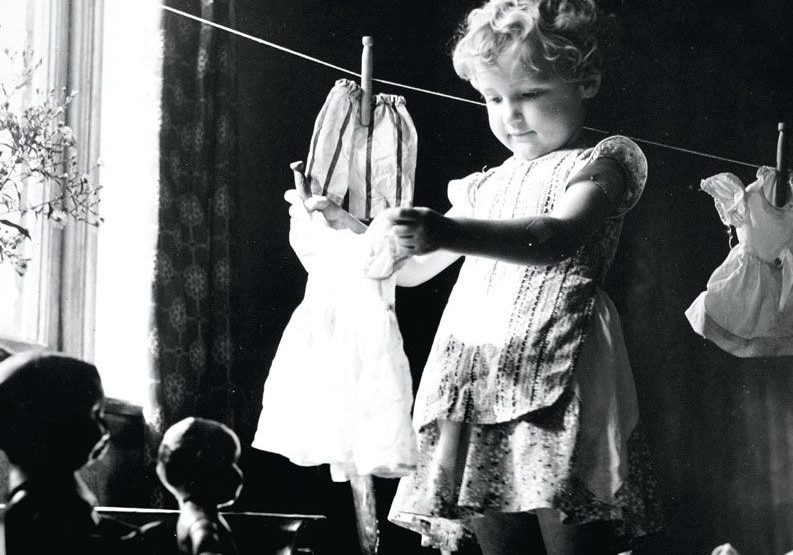
Wash Day
by Patricia Rogers
It is usually people who are at the cutting edge of any particular era that get into the news reports, the pioneers and the trend setters, and it’s easy to forget that many people around them would have lived with one foot firmly in the past.
Back in the late sixties there may have been a rush of advertisements for twin tub washing machines and spin dryers but neither of those wonderful new inventions had reached our house. It had been built in the 1930s with an outside wash house included as standard and this wash house was used by my grandmother and thought of as a luxury modern convenience.
My mother was still using it in exactly the way that it had been designed for, when I started secondary school in 1968. Washday happened just once a week, it took all day, and it was on a Monday. Always. Everybody else washed on a Monday too. It was thought untidy and slovenly to have washing hanging around on lines later on in the week. It was also a day when you could make cooking the family dinner easier on a busy day by eating left over roast beef from Sunday and sticking a rice pudding in the oven. In the corner of the washhouse there was a brick built, coal fired, copper.
The first job on every wash day was to fill up the bowl shaped stone top with cold water from the washhouse tap, put the soft wooden lid back over it and light a fire underneath, in the space behind a little metal door to heat it up. This took time and care, and required an early start, but by the time that I went to school steam would be creeping over the top of the wash house door up into the fresh air and my mother would be outside with her pinny and her Perdio transistor radio positioned on the water butt, even if was raining. The atmosphere inside the wash house would be warm, soggy and fragrant with soap. They were ready to get started. The clothes were carefully sorted, but all of them received the same pounding in a grey metal dolly tub full of hot water with soap added to it, shaved from a large green bar. Using a peggy stick, a wooden three legged stool on a long stick with a cross handle, was exhausting, requiring a twisting, repetitive turning motion to move the heavy clothes around in the hot water.
These clothes would need a lot of pounding, they were far dirtier than most clothes which find their way into a washing machine today as they had been worn for longer and worn while doing heavy work. It was far better exercise than any that you could find today in a modern gym. Just emptying the dirty water from the large tub down the drain before you began to rinse or wash a new load was hard enough.
Once the washing, scrubbing and rinsing was done the serious work of putting everything through the mangle began. It used to fascinate me this part, the way the clothes and sheets started off large and heavy and came out of the other side of the mangle a fraction of their former selves. Sometimes I was allowed to turn the handle but I was not strong enough to manage even that for long, especially the first time that a sodden sheet or some heavy cord trousers were put through.
It took two people to manage a large double sheet as the moment it was allowed to hit the floor pride demanded that you start all over again. You could never, and I mean never, put washing on the line which had marks on it. “Folks might see.” The job had to be done right and it was one of the main ways that women showed other women that they had standards. The washing lines, held up with home made wooden props, were strung out all over the back garden and carefully cleaned with a damp cloth before the start of each wash day.
A whole family’s washing including towels and bedding took up a considerable amount of space and the number of lines of washing which you had put out was something else to take pride in. Clothes and bedding were taken down, folded into wicker baskets, and replaced as they dried. A good drying day (sun and wind but not too much of it) was something which was much longed for. It made light work of everything and you could get on faster. Making good time was another matter of pride. Pegging things out was an art. There was a way of making sure that each item was hung out so that it would dry evenly and as quickly as possible and I was shown it. You told your neighbours at the end of the day what time you had managed to finally get everything dry and folded, but they would probably have noticed anyway.
The one thing everybody dreaded was having to bring clothes into the house to dry, where there was little space and you could do without extra dampness. Damp was much feared in the days before central heating, especially in the winter. I was allowed to follow on behind with a peg bag and hand out the wooden pegs one by one. Each of those pegs was special, hand carved by the ‘gypsies’ who came to the door. I was also allowed to check how dry things were.
There was a perfect moment to take them down from the line, the moment when they were dry, but not too dry to make ironing difficult. In the depths of winter the clothes would freeze into surreal stiff shapes, and I could imagine that there were people in them. I especially liked to help with the sheets when they were folded, there was a ritual dance like element to it which made it fun. I followed the movements of my mother or grandmother in a precise pattern, watching what they did and copying them, while the sheet got smaller and smaller as we walked backwards and forwards towards each other and away again.
Tuesday was ironing day, and nothing was left unironed. Even dusters.





